2004 ISUZU TF SERIES air condition
[x] Cancel search: air conditionPage 2651 of 4264
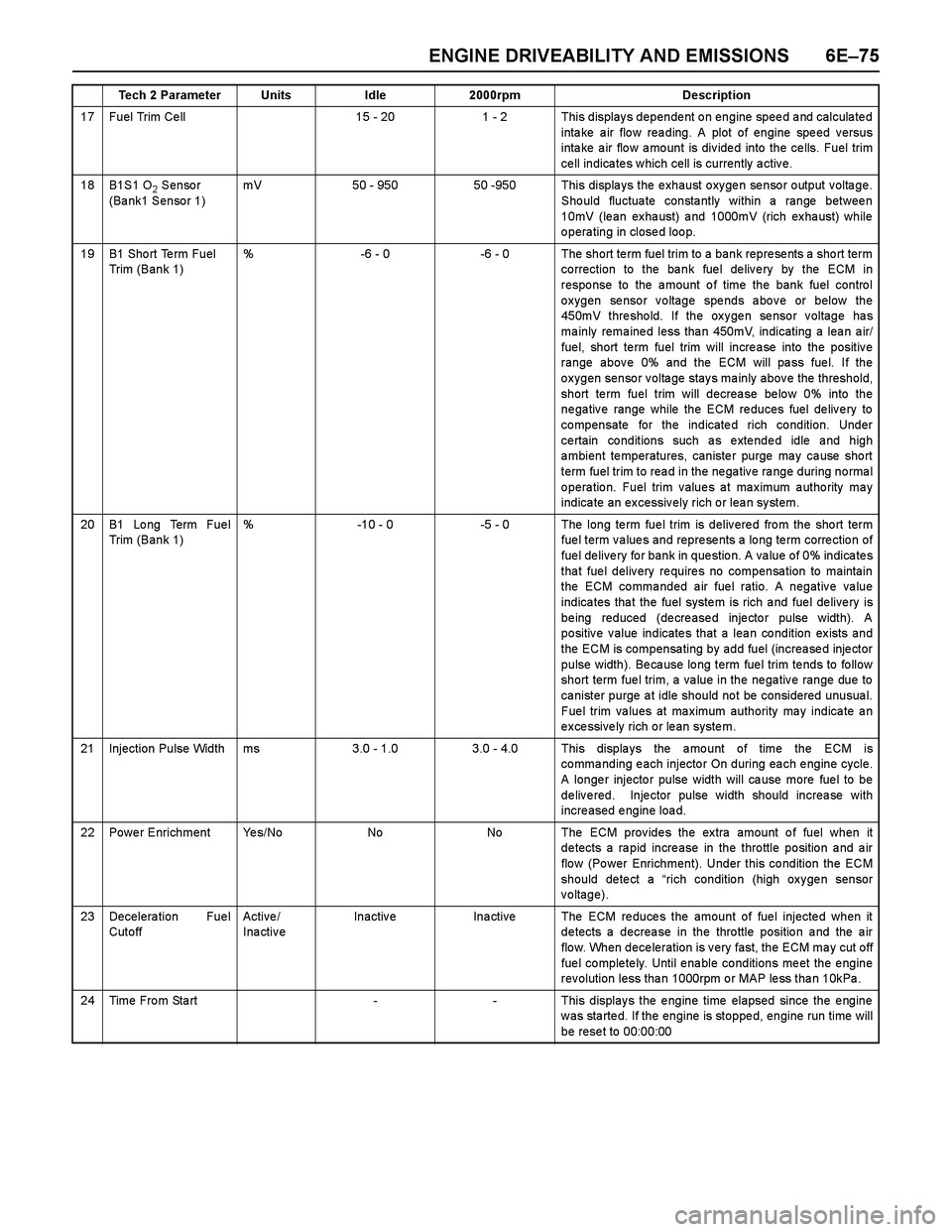
ENGINE DRIVEABILITY AND EMISSIONS 6E–75
17 Fuel Trim Ce ll15 - 201 - 2 This displays dependent on engine speed and calculated
intake air flow reading. A plot of engine speed versus
inta ke a ir flo w a mo unt is div ide d into the ce lls. Fuel trim
ce ll indica te s w hich cell is currently a ctiv e.
18B1S1 O2 Sensor
(Bank1 Sensor 1)mV50 - 95050 -950 This displays the exhaust oxygen sensor output voltage.
Should fluctuate constantly within a range between
10mV (lean exhaust) and 1000mV (rich exhaust) while
operating in closed loop.
19B1 Sho rt Te rm Fuel
Trim (Bank 1)%-6 - 0-6 - 0 The short term fuel trim to a bank represents a short term
co rrection to the ba nk fue l de liv e ry by the ECM in
response to the amount of time the bank fuel control
oxygen sensor voltage spends above or below the
450mV threshold. If the oxygen sensor voltage has
ma inly rema ine d less tha n 450mV, indicating a lea n a ir/
fue l, short te rm fuel trim will incre a se into the positiv e
range above 0% and the ECM will pass fuel. If the
oxygen sensor voltage stays mainly above the threshold,
short term fuel trim will decrease below 0% into the
negative range while the ECM reduces fuel delivery to
compensate for the indicated rich condition. Under
ce rtain co nditions such a s e xte nde d idle a nd high
ambient temperatures, canister purge may cause short
term fuel trim to rea d in the ne ga tiv e ra nge during no rma l
operation. Fuel trim values at maximum authority may
indica te an ex cessiv ely rich o r lea n sy stem.
20B1 Lo ng Term Fue l
Trim (Bank 1)%-10 - 0-5 - 0 The long te rm fue l trim is deliv ere d fro m the sho rt term
fuel term values and represents a long term correction of
fuel delivery for bank in question. A value of 0% indicates
that fuel delivery requires no compensation to maintain
the ECM commanded air fuel ratio. A negative value
indica tes tha t the fuel syste m is rich a nd fue l de live ry is
being reduced (decreased injector pulse width). A
positive value indicates that a lean condition exists and
the ECM is compensating by add fuel (increased injector
pulse width). Be ca use lo ng term fue l trim te nds to fo llow
short term fuel trim, a value in the negative range due to
canister purge at idle should not be considered unusual.
Fuel trim values at maximum authority may indicate an
excessively rich or lean system.
21Injection Pulse Widthms3.0 - 1.03.0 - 4.0 This displays the amount of time the ECM is
co mma nding e ach injecto r On during ea ch e ngine cycle.
A longer injector pulse width will cause more fuel to be
delivered. Injector pulse width should increase with
increased engine load.
22Power EnrichmentYe s / N oNoNo The ECM provides the extra amount of fuel when it
detects a rapid increase in the throttle position and air
flo w (Po wer Enrichment). Under this co ndition the ECM
should detect a “rich condition (high oxygen sensor
voltage).
23Decelera tion Fue l
Cut o ff Active /
InactiveInactiveIna ctiveThe ECM reduces the amount of fuel injected when it
detects a decrease in the throttle position and the air
flow. When deceleration is very fast, the ECM may cut off
fue l co mple te ly. Until e na ble co nditions me et the e ngine
rev olution less tha n 1000rpm o r MAP le ss tha n 10kPa .
24Time From Start--This displays the engine time elapsed since the engine
w as sta rte d. If the engine is stoppe d, engine run time will
be rese t to 00:00:00
Tech 2 ParameterUnitsIdle2000rpmDescription
Page 2686 of 4264
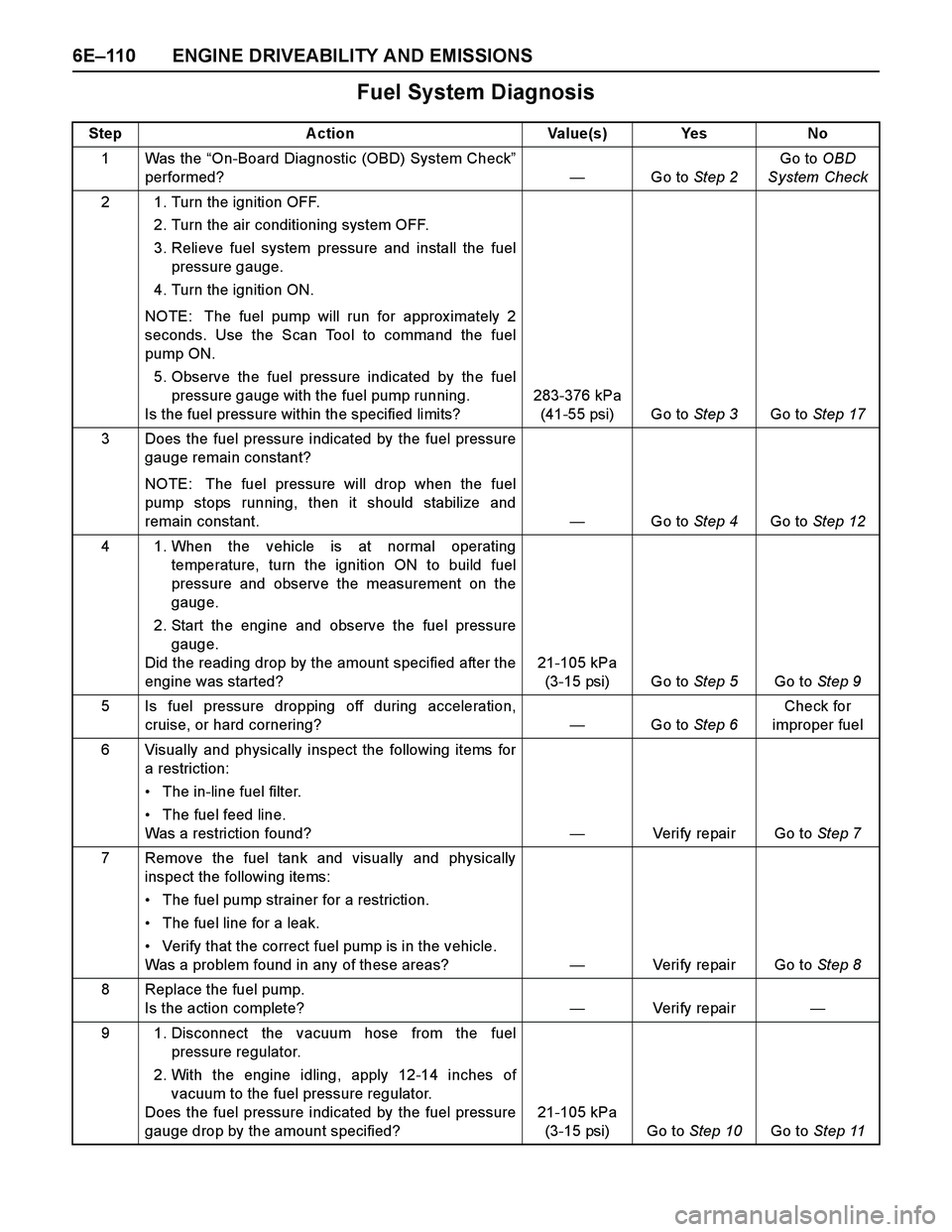
6E–110 ENGINE DRIVEABILITY AND EMISSIONS
Fuel System Diagnosis
Step Action Value(s) Yes No
1Was the “On-Board Diagnostic (OBD) System Check”
performed?—Go to Step 2Go to OBD
System Check
2 1. Turn the ignition OFF.
2. Turn the air conditioning system OFF.
3. Relieve fuel system pressure and install the fuel
pressure gauge.
4. Turn the ignition ON.
NOTE: The fuel pump will run for approx imately 2
seconds. Use the Scan Tool to command the fuel
pump ON.
5. Observe the fuel pressure indicated by the fuel
pressure gauge with the fuel pump running.
Is the fuel pressure within the specified limits?283-376 kPa
(41-55 psi) Go to Step 3Go to Step 17
3 Does the fuel pressure indicated by the fuel pressure
gauge remain constant?
NOTE: The fuel pressure will drop when the fuel
pump stops running, then it should stabilize and
remain constant.—Go to Step 4Go to Step 12
4 1. When the vehicle is at normal operating
temperature, turn the ignition ON to build fuel
pressure and observe the measurement on the
gauge.
2. Start the engine and observe the fuel pressure
gauge.
Did the reading drop by the amount specified after the
engine was started?21-105 kPa
(3-15 psi) Go to Step 5Go to Step 9
5 Is fuel pressure dropping off during acceleration,
cruise, or hard cornering?—Go to Step 6Check for
improper fuel
6 Visually and physically inspect the following items for
a restriction:
The in-line fuel filter.
The fuel feed line.
Was a restriction found?—Verify repair Go to Step 7
7 Remove the fuel tank and visually and physically
inspect the following items:
The fuel pump strainer for a restriction.
The fuel line for a leak.
Verify that the correct fuel pump is in the vehicle.
Was a problem found in any of these areas?—Verify repair Go to Step 8
8 Replace the fuel pump.
Is the action complete?—Veri fy repai r—
9 1. Disconnect the vacuum hose from the fuel
pressure regulator.
2. With the engine idling, apply 12-14 inches of
vacuum to the fuel pressure regulator.
Does the fuel pressure indicated by the fuel pressure
gauge drop by the amount specified?21-105 kPa
(3-15 psi) Go to Step 10Go to Step 11
Page 2690 of 4264
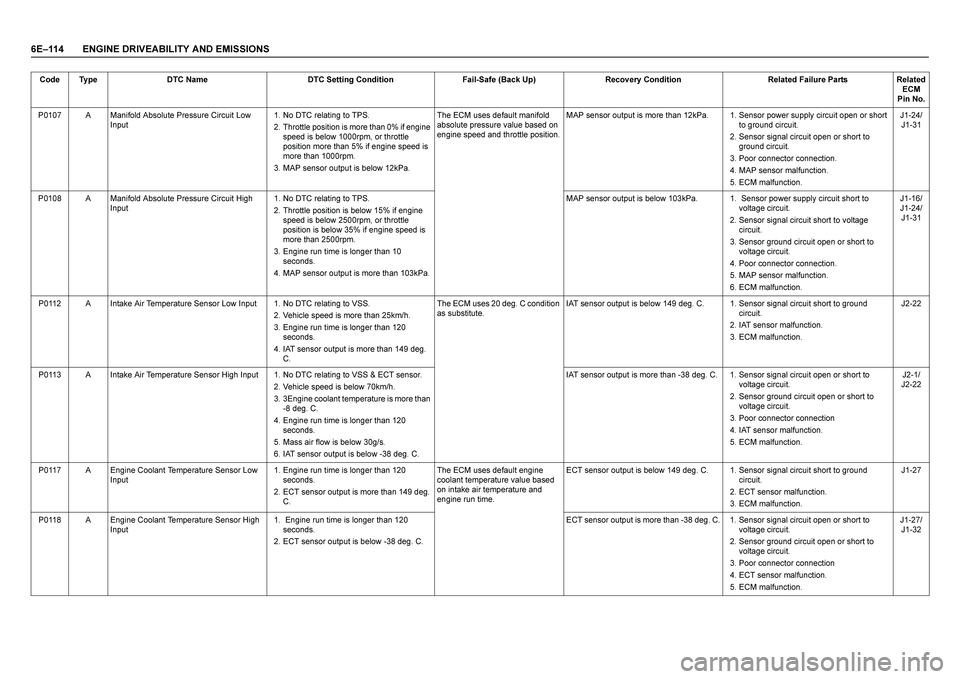
6E–114 ENGINE DRIVEABILITY AND EMISSIONS
Code Type DTC Name DTC Setting Condition Fail-Safe (Back Up) Recovery Condition Related Failure Parts Related
ECM
Pin No.
P0107 A Manifold Absolute Pressure Circuit Low
Input1. No DTC relating to TPS.
2. Throttle position is more than 0% if engine
speed is below 1000rpm, or throttle
position more than 5% if engine speed is
more than 1000rpm.
3. MAP sensor output is below 12kPa.The ECM uses default manifold
absolute pressure value based on
engine speed and throttle position.MAP sensor output is more than 12kPa. 1. Sensor power supply circuit open or short
to ground circuit.
2. Sensor signal circuit open or short to
ground circuit.
3. Poor connector connection.
4. MAP sensor malfunction.
5. ECM malfunction.J1-24/
J1-31
P0108 A Manifold Absolute Pressure Circuit High
Input1. No DTC relating to TPS.
2. Throttle position is below 15% if engine
speed is below 2500rpm, or throttle
position is below 35% if engine speed is
more than 2500rpm.
3. Engine run time is longer than 10
seconds.
4. MAP sensor output is more than 103kPa.MAP sensor output is below 103kPa. 1. Sensor power supply circuit short to
voltage circuit.
2. Sensor signal circuit short to voltage
circuit.
3. Sensor ground circuit open or short to
voltage circuit.
4. Poor connector connection.
5. MAP sensor malfunction.
6. ECM malfunction.J1-16/
J1-24/
J1-31
P0112 A Intake Air Temperature Sensor Low Input 1. No DTC relating to VSS.
2. Vehicle speed is more than 25km/h.
3. Engine run time is longer than 120
seconds.
4. IAT sensor output is more than 149 deg.
C. The ECM uses 20 deg. C condition
as substitute.IAT sensor output is below 149 deg. C. 1. Sensor signal circuit short to ground
circuit.
2. IAT sensor malfunction.
3. ECM malfunction.J2-22
P0113 A Intake Air Temperature Sensor High Input 1. No DTC relating to VSS & ECT sensor.
2. Vehicle speed is below 70km/h.
3. 3Engine coolant temperature is more than
-8 deg. C.
4. Engine run time is longer than 120
seconds.
5. Mass air flow is below 30g/s.
6. IAT sensor output is below -38 deg. C. IAT sensor output is more than -38 deg. C. 1. Sensor signal circuit open or short to
voltage circuit.
2. Sensor ground circuit open or short to
voltage circuit.
3. Poor connector connection
4. IAT sensor malfunction.
5. ECM malfunction.J2-1/
J2-22
P0117 A Engine Coolant Temperature Sensor Low
Input1. Engine run time is longer than 120
seconds.
2. ECT sensor output is more than 149 deg.
C. The ECM uses default engine
coolant temperature value based
on intake air temperature and
engine run time. ECT sensor output is below 149 deg. C. 1. Sensor signal circuit short to ground
circuit.
2. ECT sensor malfunction.
3. ECM malfunction.J1-27
P0118 A Engine Coolant Temperature Sensor High
Input1. Engine run time is longer than 120
seconds.
2. ECT sensor output is below -38 deg. C. ECT sensor output is more than -38 deg. C. 1. Sensor signal circuit open or short to
voltage circuit.
2. Sensor ground circuit open or short to
voltage circuit.
3. Poor connector connection
4. ECT sensor malfunction.
5. ECM malfunction.J1-27/
J1-32
Page 2691 of 4264
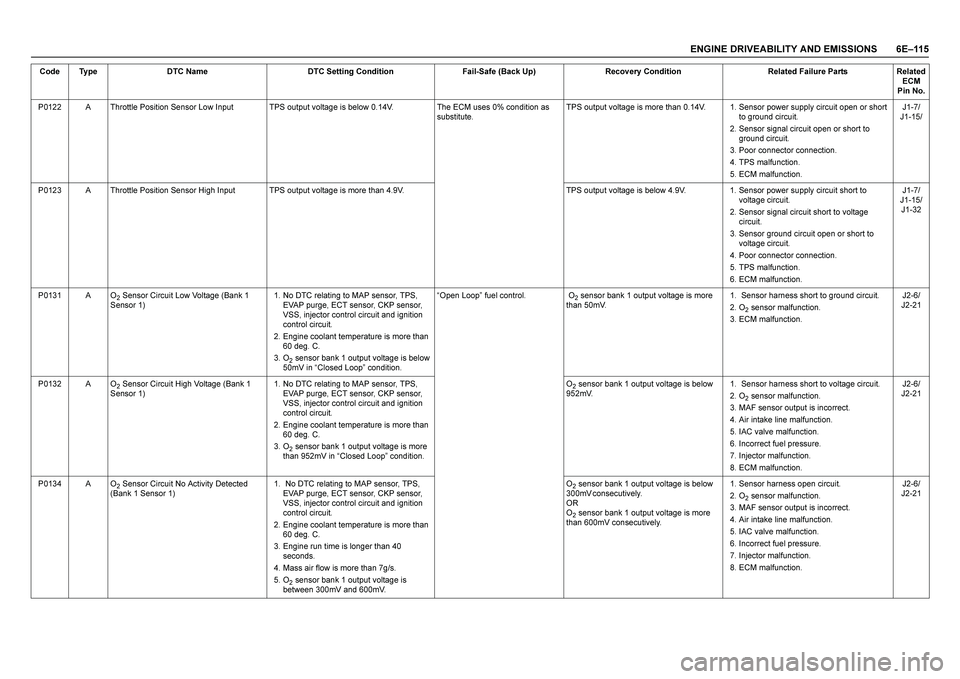
ENGINE DRIVEABILITY AND EMISSIONS 6E–115
P0122 A Throttle Position Sensor Low Input TPS output voltage is below 0.14V. The ECM uses 0% condition as
substitute.TPS output voltage is more than 0.14V. 1. Sensor power supply circuit open or short
to ground circuit.
2. Sensor signal circuit open or short to
ground circuit.
3. Poor connector connection.
4. TPS malfunction.
5. ECM malfunction.J1-7/
J1-15/
P0123 A Throttle Position Sensor High Input TPS output voltage is more than 4.9V. TPS output voltage is below 4.9V. 1. Sensor power supply circuit short to
voltage circuit.
2. Sensor signal circuit short to voltage
circuit.
3. Sensor ground circuit open or short to
voltage circuit.
4. Poor connector connection.
5. TPS malfunction.
6. ECM malfunction.J1-7/
J1-15/
J1-32
P0131 A O
2 Sensor Circuit Low Voltage (Bank 1
Sensor 1)1. No DTC relating to MAP sensor, TPS,
EVAP purge, ECT sensor, CKP sensor,
VSS, injector control circuit and ignition
control circuit.
2. Engine coolant temperature is more than
60 deg. C.
3. O
2 sensor bank 1 output voltage is below
50mV in “Closed Loop” condition. “Open Loop” fuel control. O
2 sensor bank 1 output voltage is more
than 50mV.1. Sensor harness short to ground circuit.
2. O
2 sensor malfunction.
3. ECM malfunction.J2-6/
J2-21
P0132 A O
2 Sensor Circuit High Voltage (Bank 1
Sensor 1)1. No DTC relating to MAP sensor, TPS,
EVAP purge, ECT sensor, CKP sensor,
VSS, injector control circuit and ignition
control circuit.
2. Engine coolant temperature is more than
60 deg. C.
3. O
2 sensor bank 1 output voltage is more
than 952mV in “Closed Loop” condition. O
2 sensor bank 1 output voltage is below
952mV.1. Sensor harness short to voltage circuit.
2. O
2 sensor malfunction.
3. MAF sensor output is incorrect.
4. Air intake line malfunction.
5. IAC valve malfunction.
6. Incorrect fuel pressure.
7. Injector malfunction.
8. ECM malfunction.J2-6/
J2-21
P0134 A O
2 Sensor Circuit No Activity Detected
(Bank 1 Sensor 1)1. No DTC relating to MAP sensor, TPS,
EVAP purge, ECT sensor, CKP sensor,
VSS, injector control circuit and ignition
control circuit.
2. Engine coolant temperature is more than
60 deg. C.
3. Engine run time is longer than 40
seconds.
4. Mass air flow is more than 7g/s.
5. O
2 sensor bank 1 output voltage is
between 300mV and 600mV.O
2 sensor bank 1 output voltage is below
3 0 0 m V c o n s e c u t i v e l y .
O R
O2 sensor bank 1 output voltage is more
than 600mV consecutively.1. Sensor harness open circuit.
2. O
2 sensor malfunction.
3. MAF sensor output is incorrect.
4. Air intake line malfunction.
5. IAC valve malfunction.
6. Incorrect fuel pressure.
7. Injector malfunction.
8. ECM malfunction.J2-6/
J2-21 Code Type DTC Name DTC Setting Condition Fail-Safe (Back Up) Recovery Condition Related Failure Parts Related
ECM
Pin No.
Page 2694 of 4264
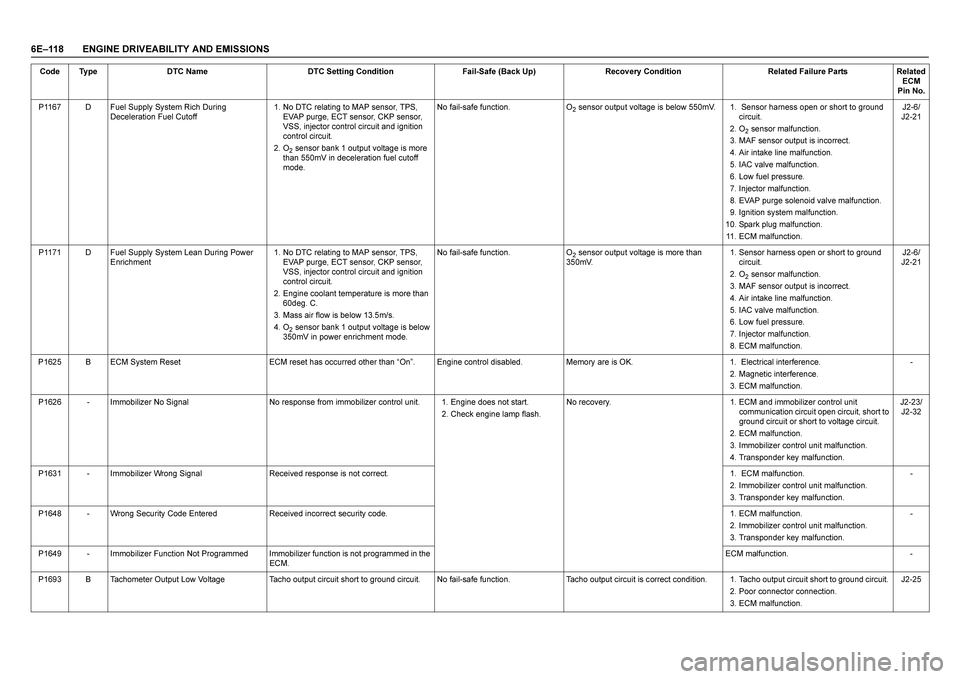
6E–118 ENGINE DRIVEABILITY AND EMISSIONSP1167 D Fuel Supply System Rich During
Deceleration Fuel Cutoff1. No DTC relating to MAP sensor, TPS,
EVAP purge, ECT sensor, CKP sensor,
VSS, injector control circuit and ignition
control circuit.
2. O
2 sensor bank 1 output voltage is more
than 550mV in deceleration fuel cutoff
mode.No fail-safe function. O
2 sensor output voltage is below 550mV. 1. Sensor harness open or short to ground
circuit.
2. O
2 sensor malfunction.
3. MAF sensor output is incorrect.
4. Air intake line malfunction.
5. IAC valve malfunction.
6. Low fuel pressure.
7. Injector malfunction.
8. EVAP purge solenoid valve malfunction.
9. Ignition system malfunction.
10. Spark plug malfunction.
11. ECM malfunction.J2-6/
J2-21
P1171 D Fuel Supply System Lean During Power
Enrichment 1. No DTC relating to MAP sensor, TPS,
EVAP purge, ECT sensor, CKP sensor,
VSS, injector control circuit and ignition
control circuit.
2. Engine coolant temperature is more than
60deg. C.
3. Mass air flow is below 13.5m/s.
4. O
2 sensor bank 1 output voltage is below
350mV in power enrichment mode. No fail-safe function. O
2 sensor output voltage is more than
350mV.1. Sensor harness open or short to ground
circuit.
2. O
2 sensor malfunction.
3. MAF sensor output is incorrect.
4. Air intake line malfunction.
5. IAC valve malfunction.
6. Low fuel pressure.
7. Injector malfunction.
8. ECM malfunction.J2-6/
J2-21
P1625 B ECM System Reset ECM reset has occurred other than “On”. Engine control disabled. Memory are is OK. 1. Electrical interference.
2. Magnetic interference.
3. ECM malfunction.-
P1626 - Immobilizer No Signal No response from immobilizer control unit. 1. Engine does not start.
2. Check engine lamp flash.No recovery. 1. ECM and immobilizer control unit
communication circuit open circuit, short to
ground circuit or short to voltage circuit.
2. ECM malfunction.
3. Immobilizer control unit malfunction.
4. Transponder key malfunction.J2-23/
J2-32
P1631 - Immobilizer Wrong Signal Received response is not correct.1. ECM malfunction.
2. Immobilizer control unit malfunction.
3. Transponder key malfunction.-
P1648 - Wrong Security Code Entered Received incorrect security code.1. ECM malfunction.
2. Immobilizer control unit malfunction.
3. Transponder key malfunction.-
P1649 - Immobilizer Function Not Programmed Immobilizer function is not programmed in the
ECM.ECM malfunction. -
P1693 B Tachometer Output Low Voltage Tacho output circuit short to ground circuit. No fail-safe function. Tacho output circuit is correct condition. 1. Tacho output circuit short to ground circuit.
2. Poor connector connection.
3. ECM malfunction.J2-25 Code Type DTC Name DTC Setting Condition Fail-Safe (Back Up) Recovery Condition Related Failure Parts Related
ECM
Pin No.
Page 2695 of 4264
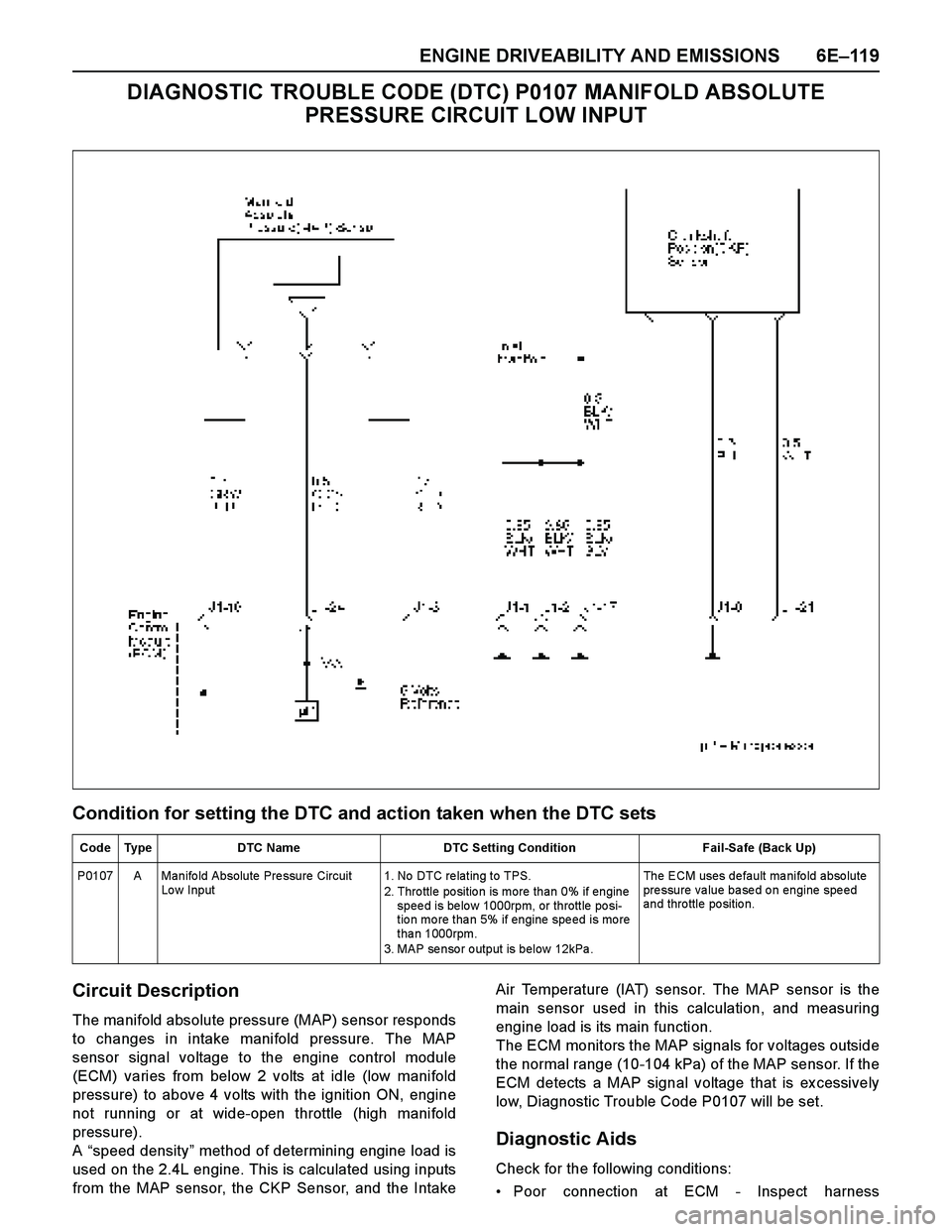
ENGINE DRIVEABILITY AND EMISSIONS 6E–119
DIAGNOSTIC TROUBLE CODE (DTC) P0107 MANIFOLD ABSOLUTE
PRESSURE CIRCUIT LOW INPUT
Condition for setting the DTC and action taken when the DTC sets
Circuit Description
The manifold absolute pressure (MAP) sensor responds
to changes in intake manifold pressure. The MAP
sensor signal voltage to the engine control module
(ECM) varies from below 2 volts at idle (low manifold
pressure) to above 4 volts with the ignition ON, engine
not running or at wide-open throttle (high manifold
pressure).
A “speed density” method of determining engine load is
used on the 2.4L engine. This is calculated using inputs
from the MAP sensor, the CKP Sensor, and the IntakeAir Temperature (IAT) sensor. The MAP sensor is the
main sensor used in this calculation, and measuring
engine load is its main function.
The ECM monitors the MAP signals for voltages outside
the normal range (10-104 kPa) of the MAP sensor. If the
ECM detects a MAP signal voltage that is ex cessively
low, Diagnostic Trouble Code P0107 will be set.
Diagnostic Aids
Check for the following conditions:
Poor connection at ECM - Inspect harness
Code Type DTC Name DTC Setting Condition Fail-Safe (Back Up)
P0107 A Manifo ld Absolute Pre ssure Circuit
Lo w Input1. No DTC re lating to TPS.
2. Throttle position is more than 0% if engine
spee d is be lo w 1000rpm, or throttle po si-
tio n mo re tha n 5% if engine spe ed is mo re
than 1000rpm.
3. MAP se nso r o utput is below 12kPa .The ECM uses default manifold absolute
pressure value based on engine speed
and thro ttle po sitio n.
Page 2699 of 4264
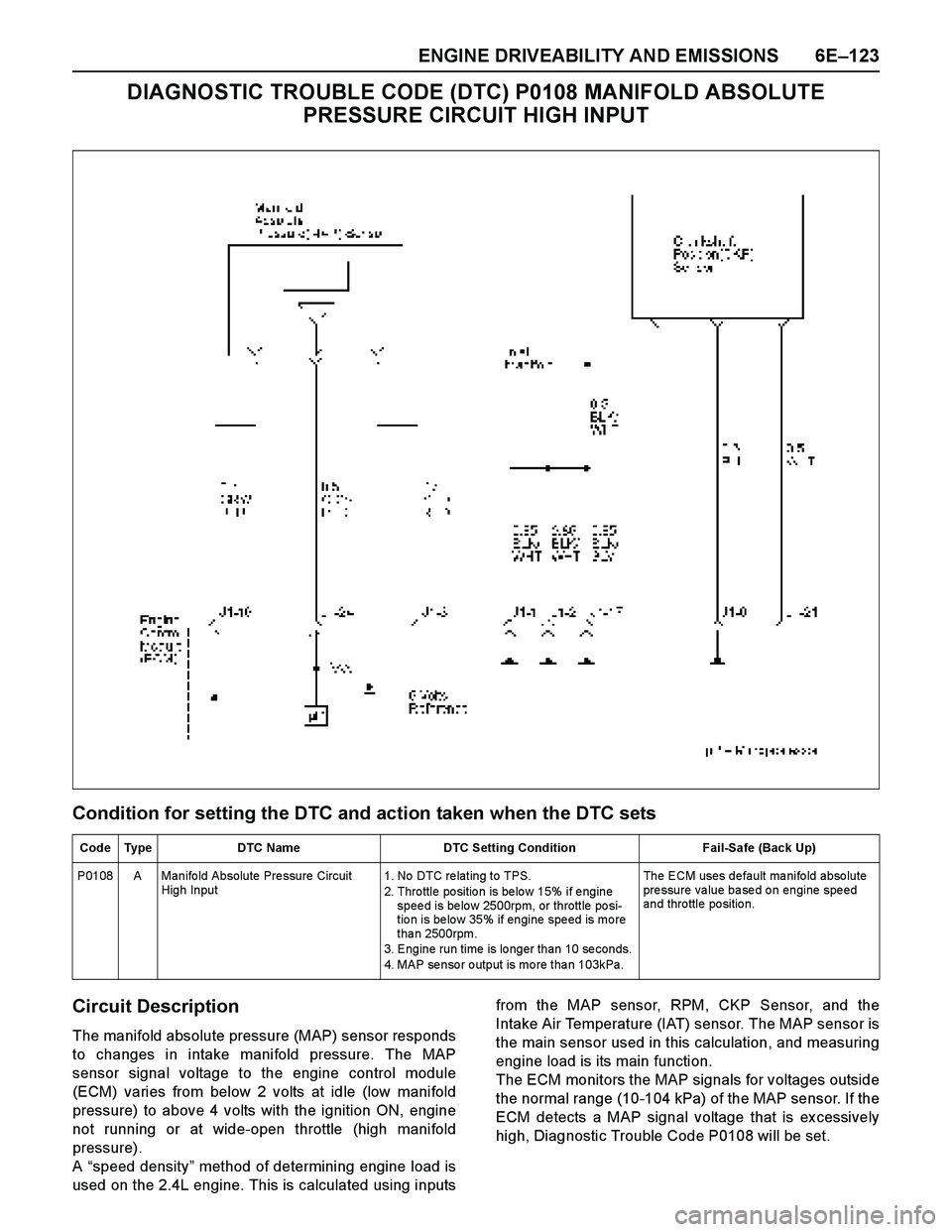
ENGINE DRIVEABILITY AND EMISSIONS 6E–123
DIAGNOSTIC TROUBLE CODE (DTC) P0108 MANIFOLD ABSOLUTE
PRESSURE CIRCUIT HIGH INPUT
Condition for setting the DTC and action taken when the DTC sets
Circuit Description
The manifold absolute pressure (MAP) sensor responds
to changes in intake manifold pressure. The MAP
sensor signal voltage to the engine control module
(ECM) varies from below 2 volts at idle (low manifold
pressure) to above 4 volts with the ignition ON, engine
not running or at wide-open throttle (high manifold
pressure).
A “speed density” method of determining engine load is
used on the 2.4L engine. This is calculated using inputsfrom the MAP sensor, RPM, CKP Sensor, and the
Intake Air Temperature (IAT) sensor. The MAP sensor is
the main sensor used in this calculation, and measuring
engine load is its main function.
The ECM monitors the MAP signals for voltages outside
the normal range (10-104 kPa) of the MAP sensor. If the
ECM detects a MAP signal voltage that is ex cessively
high, Diagnostic Trouble Code P0108 will be set.
Code Type DTC Name DTC Setting Condition Fail-Safe (Back Up)
P0108 A Manifo ld Absolute Pre ssure Circuit
High Input1. No DTC re lating to TPS.
2. Thro ttle po sitio n is be lo w 15% if e ngine
spee d is be lo w 2500rpm, or throttle po si-
tio n is be lo w 35% if engine spe ed is mo re
than 2500rpm.
3. Engine run time is longer than 10 seconds.
4. MAP se nso r o utput is mo re tha n 103kPa.The ECM uses default manifold absolute
pressure value based on engine speed
and thro ttle po sitio n.
Page 2700 of 4264

6E–124 ENGINE DRIVEABILITY AND EMISSIONS
Diagnostic Aids
Check for the following conditions:
Poor connection at ECM - Inspect harness
connectors for backed-out terminals, improper
mating, broken locks, improperly formed or damaged
terminals, and poor terminal-to-wire connection.
If these codes are also set, it could indicate aproblem with the 5 Volt reference circuit.
Damaged harness - Inspect the wiring harness for
damage; an open circuit, a short to ground, or a short
to voltage. If the harness appears to be OK, observe
the MAP display on the Tech 2 while moving
connectors and wiring harnesses related to the
sensor. A change in the display will indicate the
location of the fault.
Diagnostic Trouble Code (DTC) P0108
Manifold Absolute Pressure Circuit High Input
Step Action Value(s) Yes No
1Was the “On-Board Diagnostic (OBD) System Check”
performed?
—Go to Step 2Go to On Board
Diagnostic
(OBD) System
Check
2 1. Connect the Tech 2.
2. Review and record the failure information.
3. Select “F0: Read DTC Infor By Priority” in “F0:
Diagnostic Trouble Code”.
Is the DTC P0108 stored as “Present Failure”?—Go to Step 3Refer to
Diagnostic Aids
and Go to Step
3
3 1. Using the Tech2, ignition “On” and engine “Off”.
2. Select “Clear DTC Information” with the Tech2 and
clear the DTC information.
3. Operate the vehicle and monitor the “F5: Failed
This Ignition” in “F2: DTC Information”.
Was the DTC P0108 stored in this ignition cycle?—Go to Step 4Refer to
Diagnostic Aids
and Go to Step
4
4 Check for poor/faulty connection at the MAP sensor or
ECM connector. If a poor/faulty connection is found,
repair as necessary.
Was the problem found?
—Verify repair Go to Step 5
5 Visually check the MAP sensor.
Was the problem found?—Go to Step 11Go to Step 6
16
31 24E85 E60(J1)